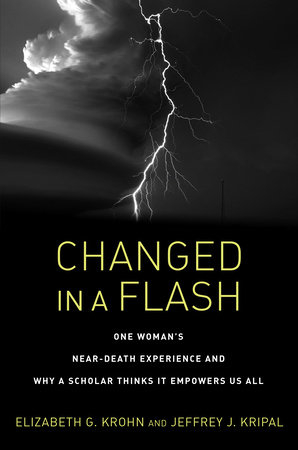
Changed in a Flash was written by Elizabeth Krohn and Jeffrey Kripal, the J. Newton Rayzor Professor of Philosophy and Religious Thought at Rice University. Kripal is not a parapsychologist but a sympathetic observer who has written several books, including Authors of the Impossible, in which one chapter was devoted to Frederic Myers and the SPR. The title, Changed in a Flash, is due to the fact that his co-author, Krohn, was struck by lightning on 2 September, 1988, and had a near-death experience (NDE). A number of books about NDEs have been written, both by researchers and experiencers: what sets this book apart is the combination - the first part is written by Krohn and the second part by Kripal.
Sometimes people who write about NDEs give the impression that they too would love to have one. However, most likely, they have either not understood or have forgotten the after-effects which are not as pleasant as many NDEs (though hellish NDEs are also reported). I am sure that Krohn could have written more about the after-effects than she did, but about 30 years after the event all changes are perhaps no longer evident to her. After the NDE she found that battery-powered watches do not work for long if she wears them, light bulbs often burn out when she walks past them, and if Krohn touches the wall panelling in her home she gets an electric shock. Oddly, after the NDE she developed synesthesia, perhaps this is related to her experience of seeing auras, but perhaps not since she writes: ”In order to see these auras I have to unfocus my eyes. A white background aids me in detecting them, although this is not always necessary” (p 57).
During her NDE Krohn felt that she spent two weeks in a beautiful garden talking with God. She is well aware that everyone will not believe her, but notes: ”Something can be perfectly true and completely unbelievable” (p. 27). I do not wish to comment on what she was told in the garden about time, souls and reincarnation – these are unverifiable claims. Many readers will, however, find those sections and Kripal's commentary interesting.
After her NDE Krohn started having precognitive experiences, primarily dreams, she did not welcome this or the moral dilemmas they can evoke at all: ”Do I have a duty to warn the entire city of San Francisco if I feel a huge earthquake is going to strike there? As many times as I have been accurate in my precognitive visions, I have been off-by a day, a week, or even a month. Or because the dreaded event fortunately never happened” (pp. 86-87). Kripal believe that psychic abilities provide a survival advantage and although one can find evidence and cases in line with this hypothesis the fact remains that many paranormal experiences are of no use to the percipient. Concerning Krohn's precognitive dreams Kripal acknowledges: ”The email data as it stands at the moment is extremely suggestive for those who are already open to the possibility that precognition is a real thing, but they do not constitute scientific proof of precognition, and the data certainly will not convince the committed skeptic. I want to be very clear about that” (p. 297). This does not diminish the value of the book.
Kripal's own contribution is meant to provide: ”(1) historical contexts, (2) cross-cultural comparisons and (3) interpretive strategies from both the Jewish tradition and the comparative study of religion ...” (p. 128). To some extent, then, Changed in a Flash is similar to The Super Natural which Kripal cowrote with Whitley Strieber, well-known for his many strange experiences. Kripal writes well, but after having read Krohn's tale about what occurred to her, his contribution might well come across as a bit abstract and the relevance of everything is not obvious. A minor omission is that when he mentions the movie What Dreams May Come he does not tell the reader that it is based on a book with same title, by Richard Matheson: he was familiar with parapsychology, theosophy and Spiritualism and at least one edition of the book even included a reading list. The claim that ”the hyperrealistic visions catalysed by the sacred plant cultures of Latin America are highly reminiscent of near-death experiences” (p. 149) also needs to be substantiated. However, readers who appreciated Kripal's previous books will no doubt like Changed in a Flash too. That said, I am unsure about how readers primarily interested in NDEs will react when they reach the second part written by Kripal. I found it thought-provoking and can recommend this book. In general, Krohn comes across as a sane person who has had strange experiences and Kripal as a learned man trying to understand them.

